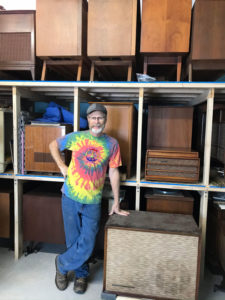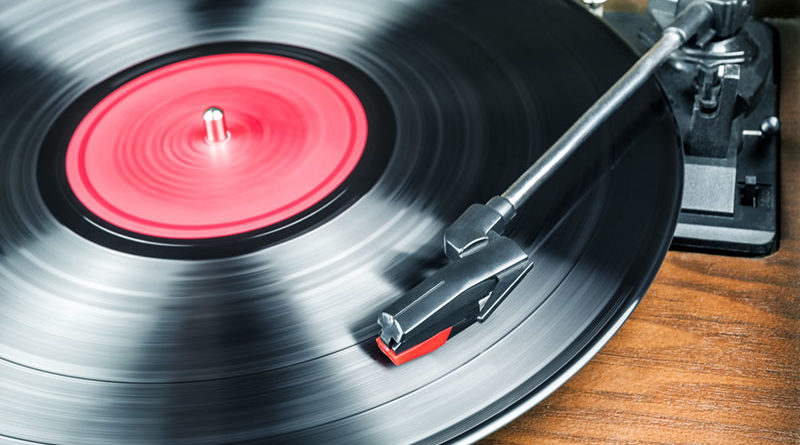Vinyl Still Going Strong
Owners of local music shops say old, young music lovers still attracted to vinyl records
By Deborah Jeanne Sergeant

LP and 45 enthusiasts have enjoyed the revival of records for the past decade — and it doesn’t look like the trend is ready to dwindle anytime soon.
Despite the convenience and ubiquity of streaming music, to some people nothing beats records for listening to their favorite music.
“It’s something to hold onto,” said Tom Little, owner of Syracuse Vintage Vinyl. “People like the music to begin with, but it’s something of substance in your hand. Everyone’s saying how it’s ‘coming back’ but it never really went away at all. There’s more people into now than 15 years ago, but the guys in my age bracket, the mid-50s, have continually been into it or were into in the day, got rid of them for CDs and now they’re buying records.”
Little has sold records for 10 years. For the first eight years, it was at flea markets and on eBay. For the past two years, he has sold from his store at 205 W. Manlius St. in E. Syracuse.
It all began when he quit drinking 11 years ago. He picked up the hobby of buying records as a positive pastime. His collection grew rapidly and he realized he needed to start selling a few records. Before he knew it, he was buying records so he could resell them to other enthusiasts.
Little said that the classic rock of the 1960s through the 1980s sells well, mostly to men aged 35 through 60.
“That demographic represents 70% of my sales of vinyl,” Little said. “The kids are getting into it, teens, 20-somethings and millennials. They share the same enthusiasm for downloads and streaming. They’re not as hardcore as the older guys. The older generation wants original pressings. The younger generation usually doesn’t care.”
Many music companies have been appealing to younger people by reissuing rock that was popular in the ‘90s and after that had never been issued on records before. Since all retro things are cool, it makes sense that records are popular with younger people.
“I have thousands of records at the store,” Little said. “I can’t really say I have a favorite as I like all kinds of stuff.”
Kathy Dunn, owner of Music and More Records in New Hartford, said she has sold vinyl all along.
“The trend has increased because of selling to the younger generation,” she said. “Overall, I’ve always sold vinyl to all ages. I have an 8-year-old who spends his weekly allowance, up to ones who are 70 years old. It’s a great industry that I don’t see ever ending.”
She sells more older country music, blues and jazz to the 55-plus crowd. The albums’ artwork and posters appeal to record buyers of all ages coming to her store.
“When I went shopping in my younger days, whenever I bought records, I judged them on the artwork,” Dunn said. “If it looked like something I liked, I would buy.”
Dunn said that new record pressings often come with a download code and possible a CD edition. But she prefers the vintage sound and likes 80s hair metal.
“A lot of newer albums are digital and sound like a CD anyway,” Dunn said. “A lot of my store is vintage vinyl as I love all the analog sound and the sizzling bacon and pops. The re-issues are digital and sound perfect. That perfect sound appeals to the younger generation. It serves the purpose.”
The quality of records has also varied depending upon the decade. Dunn said that pre-80s records were “extremely good” pressings, but by the 80s, the focus shifted to CDs, and records were thin and low-quality
“Today’s standard is 180- or 200-gram vinyl,” Dunn said. “It’s really nice stuff.”
The growth in the popularity of records has also spurred a growth in record consoles. Dan Bogel of Walworth, Wayne County, stumbled upon the console repair business. The 56-year-old works as a project manager for Best Construction in Ontario. One of his customers had a 4-foot console repurposed as a plant stand.
The customer wanted to sell it, so Bogel bought it for $50.
Always up for a challenge, he decided to restore it. By researching resources online and applying his existing knowledge of cabinetry, he completed the project. He did a few more for friends and acquaintances. His work on consoles picked up steam and he founded For The Record Stereo Console Restoration in 2017, working from his garage and eventually from a 20-by-20-foot addition he constructed.
“It’s certainly easier to do the wood than the electronics,” Bogel said.
He reaches out to many different mentors when he feels stumped.
When Bogel bought the first console, he didn’t even own any records.
“In my teens, 8-tracks were much smaller, though a record has a better quality of sound,” he said. “I didn’t have a lot of records then because I didn’t have much money.”
By the time his income increased and he began buying more recorded music, he began purchasing CDs. Now he owns 3,000 records of all genres except the one he doesn’t like: rap.
He stores many unrestored consoles and portable record players at his workshop where clients may come select the model they want. Most are older than Bogel, but some are younger adults who want a console to complement the vibe of their retro-furnished homes.
Once clients come to an agreement on the model and its price, Bogel charges a deposit and begins working.
Bogel doesn’t upgrade consoles.
“Every unit remains intact as it was when it left the factory, except adding Bluetooth capability if desired,” he said.
Every part is inspected and cleaned or, if necessary, replaced, as well as the cabinet. Some restorations take months, including a trial period where Bogel plays the console daily for a few weeks.
“Once I am satisfied with its performance, the clients may come and claim their console,” Bogel said. “Patience is a virtue I need [that] from my clients.”
So far, he has restored only 15 consoles. The cost of restoration starts at about $700.
Bogel said most of his consoles are from the 1960s.
“History is history and if the walls of the cabinets could talk, they would spin endless tales of families gathered around the precious console to listen to music,” Bogel said. “And that is it—it’s all about the records and the machines that played them.”

